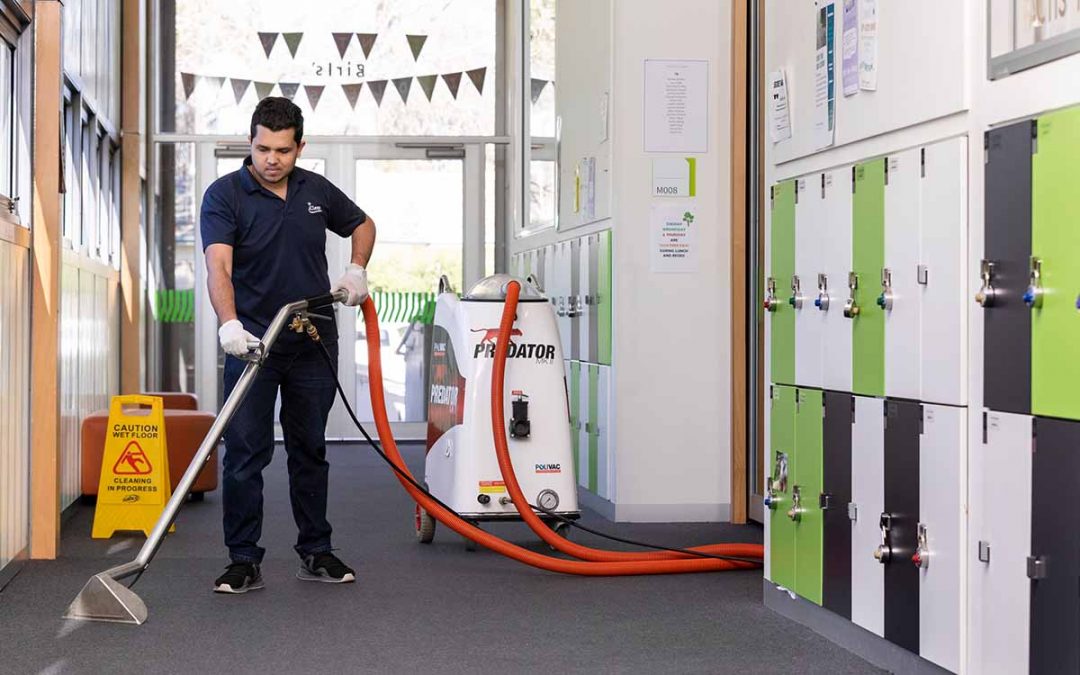FACT: Knowing how to correctly clean and disinfect schools is vital in helping slow the spread of viruses, particularly COVID-19.
Without doubt, schools are busy, active environments where a range of teachers, staff and students attend, work and interact every day. There are hundreds of surfaces and touchpoints which need to be cleaned, disinfected and sanitised to prevent any infectious diseases taking hold.
At iClean, we’re often asked about best practice methods to clean and disinfect schools, so, to keep you fully informed and up to date, we’d like to share the answers to the most common questions here.
What’s the difference between cleaning, disinfecting and sanitising?
There’s actually a big difference between these three terms.
Cleaning – This method uses detergent and water to physically remove dirt, grime and germs, such as bacteria and viruses, from surfaces and objects. Cleaning does not kill germs, however, it lowers the risk of infection by removing the germs from the surface.
Disinfecting – Is where chemicals are used on a surface to actually kill germs. By disinfecting a surface after you’ve cleaned it, you can further reduce the risk of spreading infection. It’s important to use the right products when disinfecting. In order to be effective, disinfectants often require the product to remain on the surface for a short period of time, before being rinsed clean. Be sure to follow the directions on the disinfectant’s label.
Sanitising – This reduces the number of germs to a safe level, based on public health standards, to lower the risk of infection. Sanitising is regarded as a temporary fix until you have access to proper cleaning procedures. The combination of cleaning and sanitising reduces the pathogen populations on surfaces.
What is the best method to clean and disinfect schools?
Always start with the cleanest surface first and work your way towards the more heavily soiled surfaces.
For cleaning, all that is required is to simply wash surfaces with a household or commercial cleaning product and rinse with water, in accordance with the manufacturer’s instructions. Once your surfaces are clean, it’s important to ensure they are as dry as possible, which reduces the risk of anyone slipping or falling, while also decreasing the risk of bacteria or viruses spreading through droplets.
FACT: the effectiveness of disinfectant is significantly diminished if a surface is not properly cleaned with detergent first.
When the surface is thoroughly clean and dry, follow this with high grade disinfectant to kill all germs, again following the manufacturer’s instructions. In order to kill germs, disinfectants must be left on a surface for the recommended time. Where no particular time is specified by the manufacturer, it is recommended to leave the product on a surface for ten minutes before removing it. Make sure the disinfectant product states that EPA has approved the product for effectiveness against influenza A virus.
Disinfectant wipes are ideal for use on computer keyboards, phones and electronic items that are touched often. Be mindful of the manufacturer’s instructions. If the instructions require you to keep the surface wet for a particular length of time in order to disinfect it, it may be necessary to use more than one wipe. Also, check the item’s ability to withstand the use of chemicals for cleaning and disinfecting by testing on a small section first.
Any staff members who undertake cleaning duties will need to be trained in the correct procedures for cleaning and disinfecting schools. These staff should be provided with suitable cleaning and disinfecting products, disposable cloths and any required PPE (personal protective equipment) such as gloves and/or protective eyewear. After cleaning is completed, all soiled or single use items should be placed into a plastic bag and disposed of in the general waste.
How often do surfaces and objects need to be disinfected or sanitised?
In addition to cleaning, there are surfaces and objects which also require disinfecting or sanitising on a daily basis. These include surfaces which are touched on a regular basis, such as doorways and door handles, desks, chairs, countertops, any hands-on learning items such as smart board pens, computer keyboards, toys and learning aids, just to name a few.
Specific areas, such as toilets, usually require daily disinfecting or sanitising, however the frequency will depend on your school’s cleaning procedures and regime.
Recent studies have shown that most viruses can live on a surface for up to 48 hours after making contact with the surface. However, as flu viruses are relatively fragile, standard cleaning and disinfection practices will remove or kill the germs.
Which safety precautions do schools need to follow with cleaning chemicals?
When it comes to using cleaning chemicals, particularly in the school environment, safety is vitally important. Firstly, read and pay close attention to the directions on the product label as well as any hazard warnings. Some products will require the use of gloves and/or protective eyewear.
Do not mix chemicals together. Be aware that, if certain chemicals are mixed together, they can become extremely dangerous, e.g. chlorine bleach and ammonia cleaners, which can result in the serious injury or death of the user.
Don’t we need to do a full-scale clean on a regular basis?
It is unnecessary to do full-scale frequent cleaning and disinfection such as wiping down walls and ceilings, fumigating and using room deodorisers. In fact, these can often cause harmful irritation of the eyes, nose, throat or skin, trigger asthma or cause other side effects, some of which can be serious.
We trust the above mentioned tips will provide you with the information you need to clean and disinfect your school to slow the spread of viruses.
Need more information?
If you have further questions about how to clean and disinfect your school, iClean can help. Simply call me on 1300 763 356 or email your questions to sales@icleanfs.com.au. Looking forward to hearing from you.


Recent Comments